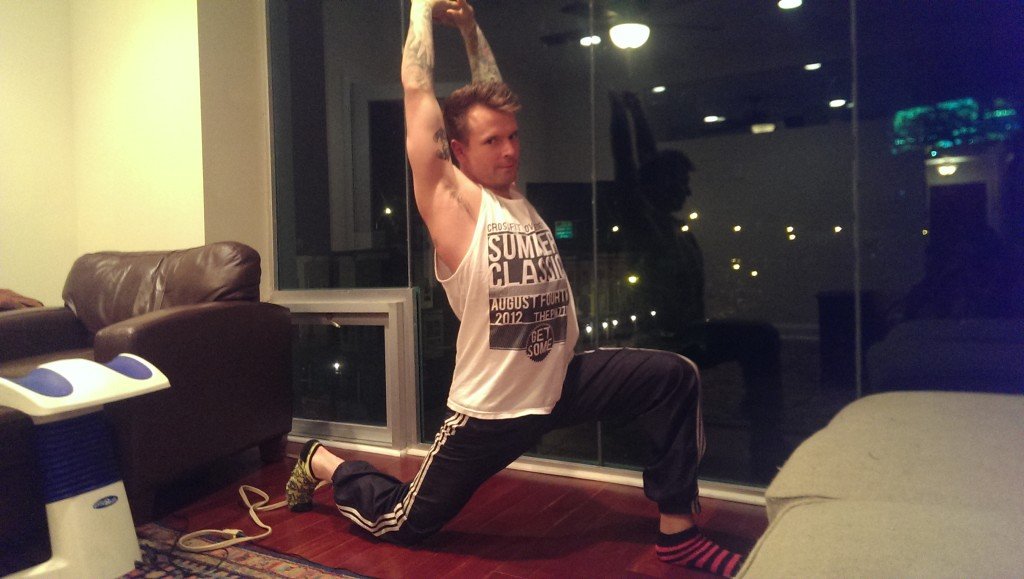Fellow workout enthusiasts! As some of you might know, I have chronic back pain that sometimes sidelines me during workouts. I’ve searched far and wide, bought strange products from infomercials and seen back alley acupuncturists (I hope that was a needle, for his sake and mine). My quest has recently brought me to a great book, and an awesome chiropractor.
I’ll start with the chiropractor. I’ve seen many, and was put off by requests for x-rays and what seemed like excessive visits (3 times a week??? I don’t even see my girlfriend that much.) Then, a member of our gym referred me to Vince Petrelli. His approach is always unique. If you’ve been to a chiropractor more than once it’s likely that they gave you exactly the same cookie cutter adjustment. Not only does Petrelli do a great job with the snaps, crackles, and pops, but he’ll also give you rehab exercises for what ails you. In my case, he prescribed the following stretch to loosen my hip flexors. If you’ve been in any of my classes in the last few months then there’s a good chance I’ve asked you to perform this during a warm up. Any good masseuse (or CrossFit mobility coach like our lovely Mischa) will tell you that the area of the body where you’re experiencing pain is probably not the cause of the problem. Generally one part of our body overcompensates for a muscle weakness somewhere else. So for me, even though it feels great to mobilize and smash those inflamed lower back tissues with a foam roller or lacrosse ball, it’s not addressing the real problem. If you have low back pain, there’s a good chance it’s due to tight hip flexors, especially if you sit for long periods.
I suggest doing this stretch periodically throughout the day. At least ten seconds on each side, and at least three times each side. This stretch is also one you can perform without laying down or putting yourself in a compromising or socially unacceptable position. SO THERE’S NO EXCUSE NOT TO DO IT! I’m always looking for ways to make a stretch more of a full body movement, and when I do this I like to clasp my hands overhead, palms up, and drive my arms behind me while keeping my chin up. This will open up your shoulders like a supple young Cirque De Soleil acrobat! Pay close attention to your spinal stability as you go, the stretch should occur in the hip flexor, not the lower back. So squeeze your abs and keep that spine stable!
If you’re looking for some light Sunday reading, I suggest Stuart McGills “Ultimate Back Fitness”. I like to play Justin Timberlake’s “Sexy Back” while I read it. I light incense too. Don’t call me on a Sunday, I’m busy. No but seriously, it’s a great book. I’ll save you guys the trouble and try to uber condense the main points for you. First and foremost, the back is unlike any other set of muscles in the body. Especially the low back. Many of the exercises that can harm the lower back are the same exercises we use to strengthen it. So listen to your body! Don’t be a meathead! One of the things that makes CrossFit so awesome is how we push each other, but we have to know our limits. It’s fine to push those limits, but don’t be too proud to back off the weight on a heavy deadlift in a workout so that you can put your pants on the next morning without screaming bloody murder. If you feel yourself getting fatigued in those muscles, you can also switch to doing singles of a weighted movement (i.e. single clean and jerks in “Grace” instead of touch and go). Many times what’s actually firing up the muscle even more is controlling it on the way down to the floor, especially if we’re not keeping the weight close to our body.
One of the best things I learned was that flexibility in the spine itself, is not a good thing. The muscles around the spine should be flexible, but the spine should not. One of the ways our backs protect themselves is actually by losing flexibility as we age. Elderly people lose flexion and extension in the spine but report that back pain is much less acute. So do yoga but remember you’re not trying out to be an extra in “The Ring part 6.”
The two big exercises McGill recommends for Spinal Stability are the bird dog and the side plank. He also recommends a modified sit up called a curl up, but ab mat sit ups are a great sub. These should be performed as warm ups. Remember these exercises are rehab/kinesthetic awareness builders. Not the same as a ME bench press.
When side planking, our focus is keeping our hips elevated, and vertical body alignment (imagine being sandwiched between two panes of glass, or if you’re a Star Wars fan being in the trash compactor in episode IV). Stack your feet on top of each other, and if you want to work a little harder, then plank on your hand instead of your forearm. Congratulations, if you can hold this position for more than 70 seconds you’re at a considerably lower risk of having a sports hernia.

Our second exercise is the bird dog. Our focus here is keeping a straight line from finger tips to toes, and maintaining the shoulders and hips in line with each other. Make sure the lower back is flat (do not let your stomach relax and drop). Unlike the plank, this move should not be held for more than 8 seconds per side. Repeat up to six times per side.
